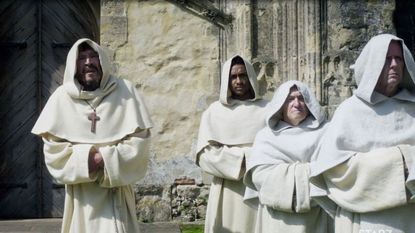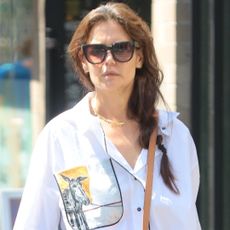

To cast a person of color in this show would be a stark anachronism." That's what Emma Frost was told after asking The White Princess' on-set historian if there were people of color in Tudor England. Let's just say his answer didn't sit well.
"There is an assumption that on a show like this, everyone is going to be cast as white," the showrunner/writer/executive producer told MarieClaire.com. "People don't usually question it, and it's perpetuated by the fact that almost every movie and TV show made about this period is white-washed. His answer just annoyed me—there was no context, evidence, or backup for that statement."
So she embarked on a mission to prove him wrong—roping in her script team to spend hours researching the history of people of color in Tudor England, which, turns out, is much more robust than TV's white lens will have you believe.
"When you're making a show about people who have been excluded from history—as women have—it would be entirely hypocritical to exclude other groups of people."
"I spent a couple of hours Googling and found two books," Frost says, citing Blackamoores: Africans in Tudor England, Their Presence, Status and Origin by Onyeka Nubia and Black Africans in Renaissance Europe by T. F. Earle and K. J. P. Lowe. "It's all there to be found for someone who can be bothered. And what you find is that there were a considerable number of people of color in England—particularly around the port towns."
And so, The White Princess went from being a show entirely populated by white people (which again, is historically inaccurate) to a show featuring people of color. [Edit lang='EN-GB"> a regular musician at the courts of both Henry VII and Henry VIII.']
"We examined as many roles as we could to readjust the balance," Frost says. "Because when you're making a show about people who have been excluded from history—as women have—it would be entirely hypocritical to exclude other groups of people who have also been excluded from history. It became important to me to look at how other groups' history had been lost, and try to reclaim it and reframe it in the show."
Since The White Princessis is based on Tudor history and the British royal family is as white as they come, Frost was unable to cast people of color as the main cast. But she says that she made a concerted effort to include non-white people in court scenes (as well as non-court scenes)–and made sure there were speaking parts.
Stay In The Know
Marie Claire email subscribers get intel on fashion and beauty trends, hot-off-the-press celebrity news, and more. Sign up here.
RELATED STORY

Of course, at the end of the day what TV needs more of is stories where marginalized groups are in the *foreground*, not the background. And next on Frost's wish-list is a show about Catherine of Aragon and her lady in waiting—a woman from Africa about whom next to nothing is known about because (ugh) history is written by white men.
"What's really exciting about the story of Catherine of Aragon actually, is that her main lady in waiting—which is a very senior role—was an African woman called Catalina," Frost says. "The show would recover an African woman from history that people didn't know."
Make this, please, Emma Frost. It's time.
Follow Marie Claire on Facebook for the latest celeb news, beauty tips, fascinating reads, livestream video, and more.

Mehera Bonner is a celebrity and entertainment news writer who enjoys Bravo and Antiques Roadshow with equal enthusiasm. She was previously entertainment editor at Marie Claire and has covered pop culture for over a decade.
-
 Meryl Streep Reveals That Skinnydipping at 5 O'Clock In the Morning Is Something Her ‘Big Little Lies’ Co-Star Nicole Kidman Apparently Enjoys
Meryl Streep Reveals That Skinnydipping at 5 O'Clock In the Morning Is Something Her ‘Big Little Lies’ Co-Star Nicole Kidman Apparently EnjoysStreep presented Kidman with a lifetime achievement award on Saturday, and said it was “impossible not to be in awe of her" (referring more to her work than her early morning dips in the Pacific).
By Rachel Burchfield Published
-
 Katie Holmes Finds the Least Basic White Button-Down
Katie Holmes Finds the Least Basic White Button-DownHers has a playful illustrated twist.
By Halie LeSavage Published
-
 There’s A Poignant Reason Why Prince Harry and Meghan Markle’s Upcoming Visit to Nigeria Will Be Especially Meaningful to Them
There’s A Poignant Reason Why Prince Harry and Meghan Markle’s Upcoming Visit to Nigeria Will Be Especially Meaningful to ThemThe couple will travel there next month, following a stop for Harry in the U.K. to mark the Invictus Games’ 10-year anniversary on May 8.
By Rachel Burchfield Published
-
 The Unstoppable Alia Bhatt
The Unstoppable Alia BhattBollywood’s silver-screen darling is both at the top of her game and just getting started.
By Neha Prakash Published
-
 The 30 Best Movies on Hulu Right Now
The 30 Best Movies on Hulu Right NowFrom 'Fight Club' to '10 Things I Hate About You.'
By Brooke Knappenberger Published
-
 Queen Elizabeth Has Passed Away at 96
Queen Elizabeth Has Passed Away at 96After a 70-year reign, the queen passed away at her home in Balmoral, Scotland.
By Jenny Hollander Published
-
 The 50 Best '80s Movies
The 50 Best '80s MoviesAn official roundup of the decade's standout films.
By Quinci LeGardye Last updated
-
 Elizabeth Lail and Dustin Milligan Compete in 'How Well Do You Know Your Co-Star?'
Elizabeth Lail and Dustin Milligan Compete in 'How Well Do You Know Your Co-Star?'The stars of 'Mack & Rita' could barely hold it together during a round of trivia.
By Brooke Knappenberger Published
-
 Charli XCX Isn't Here to Appease Anyone
Charli XCX Isn't Here to Appease AnyoneThe pop star talks authenticity, her new album, and taking care of herself while on tour.
By Gabrielle Ulubay Published
-
 What 'Femininity' Means in 2022
What 'Femininity' Means in 2022Malala, Amanda Gorman, Priyanka Chopra Jonas, and more define the word on their own terms.
By Neha Prakash Published
-
 Gossiping With DeuxMoi, the Internet's Lady Whistledown
Gossiping With DeuxMoi, the Internet's Lady WhistledownThe woman behind social media's "Society Papers" dishes on being the keeper of Hollywood's secrets and names her Diamond of the Season.
By Neha Prakash Published